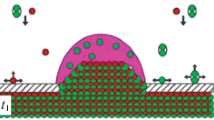Abstract
Nanowhisker formation on substrates activated by catalyst drops is studied by Monte Carlo simulation. Dependences of the whisker growth rate on diameter are investigated for various growth modes. The influence of deposition conditions on whisker morphology is examined. It is shown that straight thin whiskers of uniform thickness can be obtained only using a catalyst having a large contact angle with the whisker material. In such a physicochemical system, variation of growth conditions can result in nanotube formation. An atomic mechanism for the formation of a hollow whisker is proposed. Ranges of model growth conditions suitable for the growth of nanowhiskers and nanotubes are determined.
Similar content being viewed by others
References
Y. C. Cui, Q. Wei, H. Park, and C. M. Lieber, “Nanowire Nanosensors for Highly Sensitive and Selective Detection of Biological and Chemical Species,” Science 293, 1289 (2001).
N. J. Quitoriano, M. Belov, S. Evoy, and T. I. Kamins, “Single-Crystal, Si Nanotubes, and Their Mechanical Resonant Properties,” Nano Lett. 9(4), 1511 (2009).
E. Givargizov, “Controlled Growth of Whisker Crystals and Design of Single Crystal Whisker Probes,” Kristallografiya 51(5), 947 (2006).
O. Hayden, R. Agarwal, and W. Lu, “Semiconductor Nanowire Devices,” Nano Today 3(5/6), 12 (2008).
L. J. Lauhon, M. S. Gudiksen, D. Wang, and Ch. M. Lieber, “Epitaxial Core-Shell and Core-Multishell Nanowire Heterostructures,” Nature 420, 57 (2002).
N. D. Zakharov, P. Werner, G. Gerth, et al., “Growth Phenomena of Si and Si/Ge Nanowires on Si(111) by Molecular Beam Epitaxy,” J. Cryst. Growth. 290(6) (2006).
E. Givargizov, Vapor Growth of Whisker and Plate Crystals (Nauka, Moscow, 1977) [in Russian].
V. G. Dubrovskii and N. V. Sibirev, “General Form of the Dependences of Nanowire Growth Rate on the Nanowire Radius,” J. Cryst. Growth 304, 504 (2007).
J. Westwater, D. P. Gosain, S. Tomiya, et al., “Growth of Silicon Nanowires via Gold/Silane Vapor-Liquid-Solid Reaction,” J. Vac. Sci. Technol. B 15(3), 554 (1997).
I. Regolin, D. Sudfeld, S. Luttjohann, et al., “Growth and Characterization of GaAs/InGaAs/GaAs Nanowhiskers on (111) GaAs,” J. Cryst. Growth 298, 607 (2007).
E. P. A. M. Bakkers and M. A. Verheijen, “Synthesis of InP Nanotubes,” J. Amer. Chem. Soc. 125(12), 3440 (2003).
M. Nolan, S. O’Callaghan, G. Fagas, et al., “Silicon Nanowire Band Gap Modification,” Nano Lett. 7(1), 34 (2007).
T. Vo, A. J. Williamson, and G. Galli, “First Principles Simulations of the Structural and Electronic Properties of Silicon Nanowires,” Phys. Rev. B 74, 045116 (2006).
I. G. Neizvestny, N. L. Shwartz, Z. Sh. Yanovitskaya, and A. V. Zverev, “3D-model of epitaxial growth on porous {111} and {100} Si surfaces,” Comput. Phys. Commun. 147, 272 (2002).
A. V. Zverev, K. Yu. Zinchenko, N. L. Shwartz., and Z. Sh. Yanovitskaya, “Monte Carlo Simulation of Nanostructure Growth with an Algorithm of Planning Events on the Time Scale,” Ross. Nanotekhnologii 4(3/4), 85 (2009).
J. Kikkawa, Y. Ohno, and S. Takeda, “Growth Rate of Silicon Nanowires,” Appl. Phys. Lett. 86, 123109 (2005).
S. Kodambaka, J. Tersoff, M. C. Reuter, and F. M. Ross, “Diameter-Independent Kinetics in the Vapor-Liquid-Solid Growth of Si Nanowires,” Phys. Rev. Lett. 96, 096105 (2006).
N. Zakharov, P. Werner, L. Sokolov, and U. Gosele, “Growth of Si Whiskers by MBE: Mechanism and Peculiarities,” Physica E 37(1/2), 148 (2007).
V. G. Dubrovskii, N. V. Sibirev, R. A. Suris, et al., “On the Role of Surface Diffusion of Adatoms in the Formation of Nanometer Size Whisker Crystals,” Fiz. Tekh. Poluprovodn. 40(9), 1103 (2006).
A. G. Nastovjak, I. G. Neizvestny, N. L. Shwartz, et al., “Effect of Substrate-Drop Parameters on Nanowhiskers Morphology,” in Proc. 9th Int. Workshops and Tutorials on Electron Devices and Materials (EDM-2008), Erlagol, Altai, July 1–5, 2008, p. 41.
Author information
Authors and Affiliations
Corresponding author
Additional information
Original Russian Text © A. G. Nastovjak, I. G. Neizvestny, N. L. Swartz, E. S. Sheremet, 2009, published in Avtometriya, 2009, Vol. 45, No. 4, pp. 72–79.
About this article
Cite this article
Nastovjak, A.G., Neizvestny, I.G., Shwartz, N.L. et al. Mechanisms of nanowhisker formation: Monte Carlo simulation. Optoelectron.Instrument.Proc. 45, 342–347 (2009). https://doi.org/10.3103/S8756699009040104
Received:
Published:
Issue Date:
DOI: https://doi.org/10.3103/S8756699009040104




